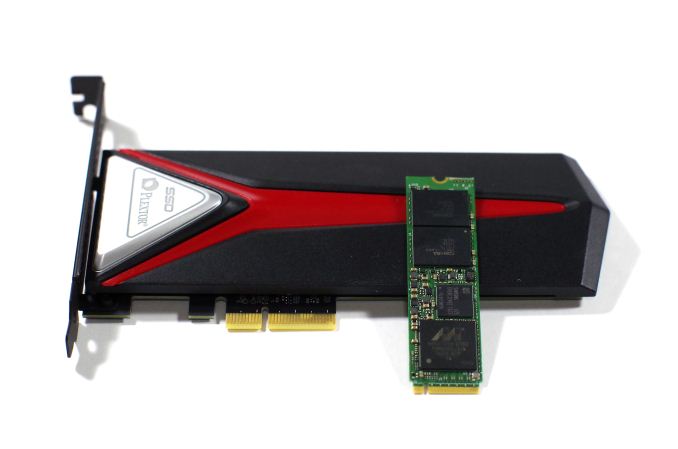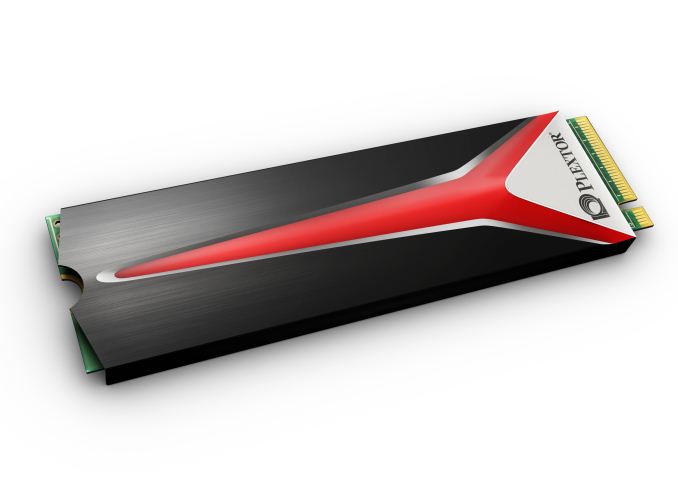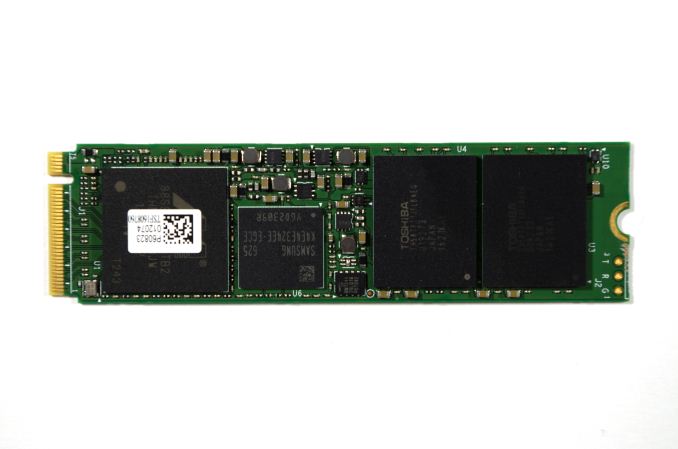The Plextor M8Pe (512GB) SSD Review
by Billy Tallis on December 14, 2016 9:00 AM EST
Plextor first entered the PCIe SSD market in 2014 with the M6e, based on Marvell's 88SS9183 controller supporting PCIe 2.0 x2 but not NVMe. In 2015 they followed it up with the M6e Black Edition that simply provided an adapter card and heatsink for an unchanged M.2 module. They also announced then delayed and eventually cancelled the M7e, which was to use the Marvell 88SS9283 to support PCIe 2.0 x4 connectivity. This year, the M8Pe finally brings a true high-end NVMe SSD to Plextor's product line.
The M8Pe series is available in three different variants, all based on the same M.2 module. The M8PeGN is the simple bare M.2 2280 card. The M8PeG adds a heatspreader that covers the top and sides of the M.2 module. This heatspreader should help alleviate the thermal throttling that all PCIe M.2 SSDs suffer from during sustained heavy benchmarking, but the added thickness will prevent it from fitting in some laptops. Finally, the M8PeY is a half-height half-length PCIe x4 add-in card adapter to house the M.2 SSD under a hefty slab of metal acting as a heatsink, and red LED accent lighting is included along the top edge of the card and under the Plextor Logo on the heatsink.
Plextor M8PeG with heatspreader
The Plextor M8Pe series shares its hardware platform with parent company Lite-On's CX2 client SSD for the OEM market. The controller is Marvell's 88SS1093 PCIe 3.0 NVMe controller codenamed "Eldora", with 8 NAND channels and support for NVMe 1.1 and LDPC error correction. The controller is a triple core design fabricated on a 28nm process. The 88SS1093 was one of the first PCIe 3.0 NVMe SSD controllers available on the open market, and it was quickly adopted for entry-level enterprise PCIe SSDs by companies like Seagate and Micron. The Plextor M8Pe is the first consumer SSD to ship with this controller. As usual, Plextor/Lite-On wrote their own firmware for use with the Marvell controller instead of adopting a reference implementation.
The M8Pe uses Toshiba 15nm MLC NAND flash to provide drive capacities from 128GB to 1TB. Performance specifications are not as high as Samsung's latest generation of NVMe SSDs based on their Polaris controller, but are similar to the earlier Samsung 950 Pro and to Toshiba's OCZ RD400. The Plextor M8Pe has a five year warranty and endurance ratings that are only slightly below that of the Samsung 960 Pro.
| Plextor M8Pe Series Specifications Comparison | |||||
| 128 GB | 256 GB | 512 GB | 1 TB | ||
| Form Factor | M8PeY: Half height half length PCIe add-in card (HHHL) M8PeG: M.2 2280 with heatspreader M8PeGN: M.2 2280 without heatspreader |
||||
| Controller | Marvell 88SS1093 | ||||
| Interface | NVMe PCIe 3.0 x4 | ||||
| DRAM | 512MB LPDDR3 | 1024MB LPDDR3 | |||
| NAND | Toshiba 15nm MLC | ||||
| Sequential Read | 1600 MB/s | 2000 MB/s | 2300 MB/s | 2500 MB/s | |
| Sequential Write | 500 MB/s | 900 MB/s | 1300 MB/s | 1400 MB/s | |
| 4KB Random Read (QD32) | 120k IOPS | 210k IOPS | 260k IOPS | 280k IOPS | |
| 4KB Random Write (QD32) | 130k IOPS | 230k IOPS | 250k IOPS | 240k IOPS | |
| Endurance | 192 TBW | 384 TBW | 768 TBW | ||
| Warranty | 5 years | ||||
| Price (M.2 only) | $84.95 (66¢/GB) | $163.16 (64¢/GB) | $249.99 (49¢/GB) | $516.57 (51¢/GB) | |
This review will primarily focus on comparing the Plextor M8Pe to other MLC-based PCIe SSDs, especially the similarly-priced Toshiba OCZ RD400 and Samsung 960 EVO. Our review sample is a 512GB M8PeY (add-in card with heatsink), so the drive has been tested both under the heatsink and as the M8PeGN in our usual plain M.2 adapter that offers no extra cooling.
Cooler drives tend to be a bit more power efficient, especially when they can avoid thermal throttling that would otherwise cripple their performance scores. However, the M8PeY's PCIe x4 to M.2 adapter wastes some power by drawing from the 12V supply and converting down to 3.3V, and spends even more on the flashing lights (about 0.5 W total). Thus, the M8PeY exhibits higher power consumption and worse efficiency on almost every test and only comes out ahead where thermal throttling most severely impairs the M8PeGN. The power efficiency comparisons in this review will focus on the M.2-only M8PeGN configuration that most laptop users would require.
Unlike Toshiba/OCZ, Samsung and Intel, Plextor has not provided a custom NVMe driver. The M8Pe has been tested with Microsoft's NVMe driver provided in Windows 8.1. As explained in our initial review of the Samsung 960 Pro, this driver has some peculiar behavior with regards to write caching performed by the SSD. The Windows default settings for NVMe drives are not comparable to the default settings for SATA SSDs or the default behavior of third-party NVMe drivers. This difference is most apparent when using benchmarking software that takes measures to ensure that it is testing the speed of the disk instead of the speed of the filesystem's cache in RAM, and the difference in behavior is seldom encountered by ordinary desktop applications. In order to provide a fair comparison against SATA SSDs and manufacturer-supplied NVMe drivers, our benchmarks of the M8Pe were run with write cache buffer flushing disabled. This is the setting that most closely approximates the behavior of other drivers.
| AnandTech 2015 SSD Test System | |
| CPU | Intel Core i7-4770K running at 3.5GHz (Turbo & EIST enabled, C-states disabled) |
| Motherboard | ASUS Z97 Pro (BIOS 2701) |
| Chipset | Intel Z97 |
| Memory | Corsair Vengeance DDR3-1866 2x8GB (9-10-9-27 2T) |
| Graphics | Intel HD Graphics 4600 |
| Desktop Resolution | 1920 x 1200 |
| OS | Windows 8.1 x64 |
- Thanks to Intel for the Core i7-4770K CPU
- Thanks to ASUS for the Z97 Deluxe motherboard
- Thanks to Corsair for the Vengeance 16GB DDR3-1866 DRAM kit, RM750 power supply, Carbide 200R case, and Hydro H60 CPU cooler


















64 Comments
View All Comments
close - Friday, December 16, 2016 - link
I'm not at all sure how dire the shortage is but there's plenty of online material for this. Of course, the titles might be apocalyptic but you can get a sense that it's not something to shrug off quite yet:http://www.digitimes.com/news/a20161212VL201.html
http://www.tomshardware.co.uk/ssd-hdd-shortage-nan...
https://www.custompcreview.com/news/nand-flash-pri...
https://epsnews.com/2016/10/12/supply-shortage-nan...
And this fits perfectly with the price trends for some SSDs. Crucial/Micron is a nice holdout but probably because of the in-house NAND manufacturing.
On a slightly unrelated note, while I consider Samsung's drives to deliver the highest performance (and use them because of this), I wouldn't say they are most balanced because of the price and implicitly the price/performance ratio. I still go with SanDisk and Crucial wherever top range performance isn't critical because I think they offer a lot more value.
jabber - Friday, December 16, 2016 - link
There is always a 'shortage' yet life and sales go on. Just market FUD too manipulate prices. Never seems to push through to retail much.shabby - Thursday, December 15, 2016 - link
Seems like you guys should be comparing every capacity of ssd when doing reviews, if samsung sends you only the 1tb version tell them where are the other two, because clearly they will be slower.Mr Perfect - Thursday, December 15, 2016 - link
Yes, and this could be played the other way, too. When Plextor sends in a 512GB drive, let them know that they'll be benched against a 1TB Samsung and will be at a disadvantage.Bruce427 - Friday, December 16, 2016 - link
The reason for the 1TB Samsung 960 EVO (only) is, at the time that 's all Samsung was shipping. I'm sure reviews on other models will follow soon.Billy Tallis - Thursday, December 15, 2016 - link
In the specific case of the 960 EVO, Samsung sent me a 1TB and a 250GB sample. The 250GB died, but I'm currently writing up the review of the replacement.Most of the companies and PR people I deal with are very understanding of my desire to test the full range of capacities. But for many product launches, the PR departments simply don't get enough supply to satisfy us reviewers. I can't even say that the executives several levels up who make those allocation decisions are wrong. Most of their benefit comes from the initial exposure of having the SSD reviewed at all. Providing a wider range of samples means they'll get mentioned more frequently as a point of comparison in future reviews, but that's a tough sell when it means a retailer like Newegg is more likely to run out before their second shipment comes in.
Some companies have indicated that they'd be open to providing further samples post-launch when supply is no longer constrained. But I'm not in a good position to ask for that when I still have a backlog of drives that haven't gotten a first review.
epobirs - Friday, December 16, 2016 - link
Also, don't be fooled by MSRP. I got the bare version of the Plextor for under $200 from Newegg recently. I wouldn't have been able to justify going PCIe with any other product I examined at the time.aeolist - Wednesday, December 14, 2016 - link
The 512GB M8Pe was $180 on Newegg over Black Friday, which made it a pretty easy choice for me. Keep an eye out over the holidays, I wouldn't be surprised to see it and the RD400 go on sale pretty significantly.icrf - Wednesday, December 14, 2016 - link
I did the same thing. And to clarify, it was the GN model, without the heat spreader. Aside from having a difficult time getting my Linux install copied over and booting properly, been happy with it, but haven't really stressed it yet.sinPiEqualsZero - Wednesday, December 14, 2016 - link
From a real-world perspective, are we at the point where we (meaning "the majority of humans") can tell the difference between an M.2 PCI-E and SATA drive during normal usage?I ask because I'm using a 1 GB ADATA drive that I picked up for $220 last year and it was a decent upgrade over my Crucial M4. I wonder if the jump from SATA to PCI-E is likewise noticeable.